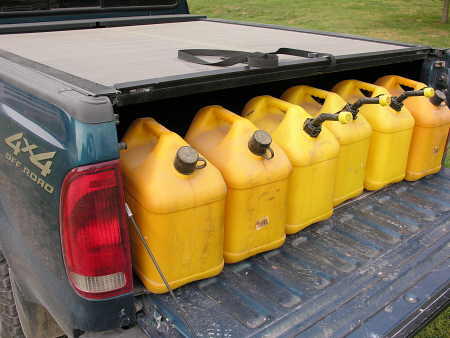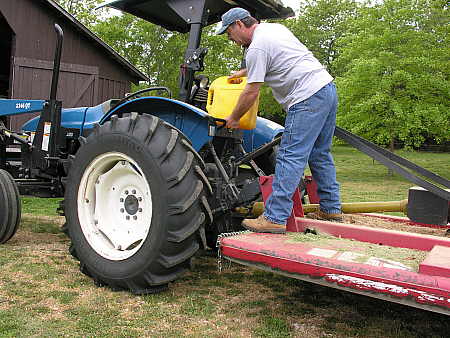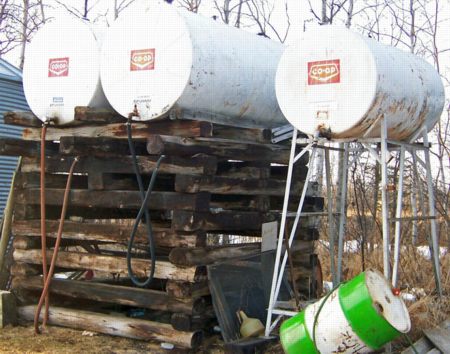
The photo above shows how we obtain our off-road diesel fuel to supply the needs of our tractor. In order to purchase off-road diesel (which is devoid of state road taxes), we must travel 16 miles each way to the nearest supplier. Safe fuel handling practices dictate that fuel containers be removed from the bed of the truck before filling, so we place the cans on the ground to pump fuel into them. The containers are then lifted back into the bed of the truck for the journey home, where they are off-loaded from the truck and carried into the barn for storage. When it is time to fuel the tractor, a container is carried from the barn out to the tractor, where it is emptied by hand into the tractor’s fuel tank. If I were to attempt this feat while standing on the ground, then the fuel filler neck would be at eye-level, which is not a particularly safe way to fill a tank with hazardous liquids! As you can see from the photo below, by elevating the bush-hog into the uppermost position, I can accomplish the refueling from a position that affords eye safety. On the other hand, it isn’t a position that is easy on the back!  Ouch!!!

Now let us do some math. Ouch!!! Okay, I’ll do the math, you just follow along with my reasoning. This tractor burns 1 gallon of fuel per hour. According to the tractor’s hour meter, I have run the tractor for a total of 1200 hours in the past 5 years. That amounts to 1200 gallons of diesel fuel. There seems to be some controversy over the weight of diesel fuel, but assuming a conservative 7 pounds per gallon as the factor, that translates into 8400 pounds of diesel fuel that the tractor has consumed. Each gallon of fuel had to be handled several times; 1) loaded onto the truck for the ride home, 2) transferred from the truck to the barn 3) carried from the barn to the tractor 4) lifted and poured into the tractor’s fuel tank. So now we have determined that I have handled a total of 33,600 pounds, or nearly 17 TONS of fuel! Ouch!!! No wonder my back sometimes hurts.
Now for some more math. Ouch!!! As you can see from the first photo, I fill 6 fuel cans at a time, because that is the number that will fit across the back of the pickup bed, affording lateral stability as I wind my way around the Ozarks landscape on my way to the filling station. I fill each container with 4.5 gallons of fuel, therefore each round trip to the station yields 27 gallons of fuel (4.5 X 6). We know from the paragraph above that we have used a total of 1200 gallons of diesel fuel, therefore we can conclude that there has been a total of 44 round trips made to obtain this fuel (1200/27=44.44). Now if we multiply the 44 round trips by 32 miles, we obtain 1408 miles traveled to fetch diesel fuel. Dividing by the abysmal 16 miles/gallon that my truck manages to achieve (he admits, covering his face in shame), and then multiplying by an average fuel price of, say, $2.00/gallon, we can determine that I have spent close to $200 just to fetch the fuel! Ouch!!! No wonder my wallet sometimes hurts.
As an aside, well, I’m almost too embarrassed to share it with you, but here goes. Over the years, I have been purchasing off-road diesel fuel for use in my tractor. As mentioned previously, off-road diesel fuel is devoid of road taxes. Sometime in the past (I don’t know when), the state legislature decided that off-road diesel should be subject to the state sales tax of 7%. So now, using today’s fuel prices, the calculus (ouch!!!) goes something like this:
Off-road diesel (16 miles away)= $2.65/gal + 7% sales tax = $2.84/gallon
On-road diesel (available locally) = $2.79/gallon
Price of my embarrassment = ???  Ouch!!!Â
But I digress.
My father used to frequently say “Son, the legs go first!” But then, he spent the better part of his life running a factory. He put many miles on the soles of his shoes, so one would expect the legs to go first.  While I do lots of hiking around the property here, I find that I am called upon to perform heavy lifting much more than I recall doing since my younger days. And so I would have to say “Dad, the back goes first!”
So the question that nags at me is this – is there a better way to accomplish this task of fueling the tractor, which, while seeming to be a trivial task, can wreak havoc on the backs of those of us who don’t feel as young as we once were?
One popular option that many farmers turn to involves the installation of an elevated, above-ground fuel storage tank, which is periodically replenished by a local fuel distributor.  These systems are gravity driven, which is both a blessing and a bane. A blessing, because pumping equipment is not required. A bane, because gravity cannot be shut off. There are many potential points of leakage in a fueling system. With gravity continuously at work, any leakage, no matter how slight, will eventually empty the tank. There was an incident that occurred about 5 years ago in an area around Beaver Lake, about 75 miles away. A fishing resort owner had a 300 gallon elevated tank installed for the convenience of his guests. The tank valve developed a leak sometime during the night, and approximately 200 gallons of fuel seeped into the water table. To make a long story short, 5 years later there are about 100 households with contaminated wells. Their water has to be delivered weekly by truck and pumped into plastic holding tanks placed on their property. The owners of the resort had to declare bankruptcy when their insurance policy reached the limit of the insurance company’s contracted liability. Ouch!!!Â
And this scenario, with some slight variations, is played out repeatedly across the country. As I was driving down the road this winter, I saw these tanks on a neighbors  farm, so I stopped to take a picture. To me, this looks like a disaster waiting to happen.Â

Were I to install a fuel tank, it would have to be built of quality parts. I would have to keep the tank, fittings, hose, valve and nozzle in tip-top condition. And the entire assembly would have have a seepage-proof containment system with capacity at least equal to the capacity of the tank. All-in-all, this would be a safe and effective system, which would certainly relieve the pains in my back, but man, would it be costly!
So it’s off to the station to fill those darn fuel cans. Ouch!!! Ouch!!! Ouch!!!



I just don’t know what to say!
You can’t pose a problem like that and expect me not to opine. It would be contrary to my genetic disposition! 😉
First, you need a fuel container that also has a transfer pump. This will solve two problems – the wheels on the tank will prevent you from having to carry all of those fuel cans, and the transfer pump will prevent you from having to lift them. You are currently transfering 4.5 Gallons x 6 containers, so a 30 gallon model would be ideal. I found one here:
http://www.shop.com/op/~Handy_All_Steel_Gas_Caddy_151_30_Gallon,_Model_12652-prod-5630475-7975709?sourceid=298
Now, you still need to remove the tank from the bed of the truck to fill it up at the gas station, and then get it back in when it is full. 30 gallons x 7 pounds a gallon means that you can’t just lift the filled tank back in. So what are we to do?
First, you need a ramp up into your truck, like this one:
http://store.rampconnection.com/product.php?xProd=6212&xSec=61
“But David!”, you say, “I still have to roll 210 pounds up that ramp.”
Well, we can solve that rather elegantly through the use of a bed-mounted winch, like this one:
http://store.summitracing.com/partdetail.asp?autofilter=1&part=SPW%2D1430200&N=%2D128296+115&autoview=sku
Voila! My work here is done.
Now, if you need me, I’ll be working on my proposal for world peace.
Well, I’d better try to say something.
I reckon I’d start working on how to get a 44 gallon drum on the back of your 4WD. Some people around here drive around with them permanently in the tray of their ute. I’ll admit they are usually cattlemen who travel roads where there are no fuel stations. They usually have a hand pump to refuel the vehicle from the 44 which sits in the back. I guess your 4WD doesn’t run on diesel. In this part of the world most 4WDs are diesel for diesel is the fuel used to run cattle station generators, graders, bulldozers etc. One fuel fits all.
So, my suggestion. You need a diesel 4WD and a hand pump. You could then get the cheaper diesel and use it in both vehicles and your back would only have to put up with turning the hand pump. Of course, I would seek help in getting the 44 into the back of the ute.
By the way – thanks for agreeing with me about the turkey shoot. Pablo certainly seems to have opened up a business proposition there. I mean, what else do you do with country that even cattlemen have abandoned??
PS – We call those bush (brush) hog things – Lawnmowers!! 😉
Pablo – Could it be that you are really at a lose for words? Was it the math?
Tjilpi – Thanks, your suggestion has put me on the right track to a solution. I’ll see if I can have the local fuel distributor drop off a few drums of diesel fuel. A hand pump, or even a portable 12 volt transfer pump could do the work, and my back would be spared (not a trivial consideration when one’s lifestyle choice depends on a healthy back).
PS – It occurs to me as I type this, maybe I can find a way to obtain drums of bio-diesel. That would make for a “green” solution as well.
Very nice post.
Sam – Thank you for the compliment.
David – Sorry your post didn’t appear here immediately. The comment spam blocker thingamajiggy put it in the moderation queue, probably because of the number of links. I now have learned that there is such a thing as a “moderation queue”, and that I am the moderator. Will wonders never cease?
I’m sure that when the genome project finishes mapping the “opining” segment of DNA, we will find we have a match. So opine away!
Now about your opined opinion re: my tank problem. Any system that requires me to purchase, maintain, and gather together 3 pieces of equipment (and remember that I have them) is entirely too complex for this tired mind, let alone my back!
But your research time (which I appreciate) is not wasted – I shall buy a ramp, as you suggested, so that we can get Gracie (our 120# Great Pyrenees) into the bed of the truck for a ride. And the winch that you suggest will be a great back-saving device for use in loading my mowers onto my trailer.
I have an even simpler solution (some shared DNA segments allow for this). 🙂
Hire some young buck with a Goliath-defeating, bicep-bulging name such as David at +20% his cost of fuel and expenses to do this young-man’s labor. I can attest first hand at the expense of a trip to the emergency room via ambulance if (when?) your back goes out suddenly and dramatically. You have not yet begun to feel the pinch of a spiteful back or wallet expense! 🙂
Hopefully, we do not share the weak back DNA strands.
When I read David’s suggestion, the first thing I did was add up the cost of the components. When it amounted to about $1000, I said to myself, “Hal, you could probably find some teenager to haul your fuel tanks for the next ten years for $1000.” That’s the shared DNA part.
My back – I blame that on an over-exuberant weight-training coach when I was in high school. His motto – “keep adding weights to the machine ’til you hear your body crack or tear.” And I believed him!
Were you an engineer or computer scientist in a past life? 🙂 Only an engineer/comp sci goes to this much trouble to figure out that their back hurts!
Love it! Keep it up!
These are the sort of things that I lie awake at night thinking about.
Pingback: Ranch Ramblins » Blog Archive » My Boots
Pingback: Ranch Ramblins » Blog Archive » How Can This Happen?
So. Ive been a mechanic since high school and just turned 50. BACK PAIN is my life; just had surgery last year and was back full bore after 6 months. Pain is a daily given but at least I don’t do the floppy chicken on the floor any more and live a relatively normal life. Anyway, I’ve seen all types of scenarios with problems like yours at first hand can give you the cheapest and easiest solution and it is will only take a wee bit longer but will save your body. It’s the best way our employer’s light vehicle shop has found to empty and fill a vehicles fuel tank when the tank has to be removed. Just take a 12 volt electric fuel pump (generic model available from any automotive store); run a short hose to you jug(s) and whatever length you need from the pump to your tractor. It will need to be hooked to your battery, so run whatever length of wire you need to reach the battery in your tractor or truck and use alligator clips to attach it to the battery. With this method you shouldn’t even need to unload the full jugs from your truck; just do it from the tail gate. A descent pump will run you 50 or more dollars but can be well worth it . you shouln’t have to prime it; just plug n play. An off/on in-line switch at the pump would be a convenience. There are lots of pricey electric fuel pumps for tanks,etc. out there but not a lot that adapt to plastic jugs. I think this method would give you the best bang for your buck. Try to get one with a metal housing to save it when it gets bumped around. Good luck, Dean
ouch man! what a pain in the but! Hope you find a solution for that!